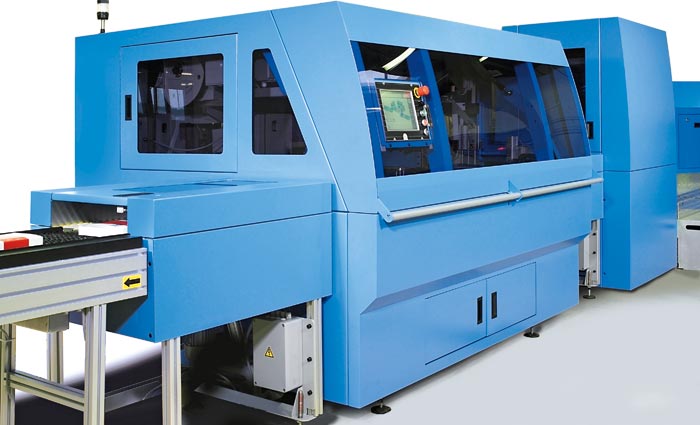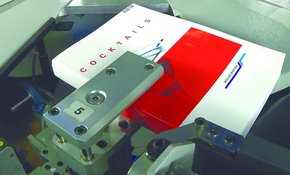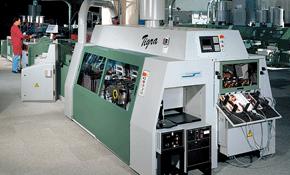
What does it do?
With the Sigma three-knife trimmer, book printers can cut books of different formats and thicknesses in quick succession, without interruption. The final format for each book is read with a barcode scanner during infeed and all settings are made automatically, cutting makeready time.
How does it work?
It uses a turntable to take each book to the machine’s three knives, accommodating five products in the trimmer at once. Each book is guided to the cutting stations by a clamp to cut the foot, then the front and finally the head. The distances between clamps and knives are individually controlled in all cutting positions, so books of different-sizes can be cut in succession.
How does this machine differ from previous Sigma models?
The Sigma Trimmer was previously only available as part of an inline binding and trimming package; it can now be installed standalone. This is useful for a range of clients who want to combine the trimmer with a binding machine already installed, says Muller Martini Australia managing director Livio Barbagallo. Particularly, digital printers with multiple production units in the low-end range can benefit from having high-quality trimming consolidated in one area. The solo version also features a large maximum foot cut-off, designed for ultra short-runs, who regularly trim a variety of final formats from a few standardised raw book sizes.
When was it launched and which markets is it aimed at?
It was launched in September at Graph Expo in Chicago. The trimmer is aimed at printers with a mixed job structure who lose significant time on the changeovers of a conventional three-knife trimmer; printers who want to enter the digital market with smaller machines; and those who print books digital and offset. It may also appeal where products vary in thickness and size from one product to another.
How fast is it?
It’s slower than most three-knife trim-mers, but Barbagallo says: “If you are doing half a million magazines, you want a trimmer that trims the same size on every magazine as quickly as possible, but if you’re doing 1,000 books and 500 are different, you need a versatile machine.”
What’s its USP?
“The Sigma Trimmer’s uniqueness is that you can have five different products in the trimmer at any one time, all of them being trimmed to a different size and thickness.”
How easy is it to use?
“If you have the barcodes, you just press the green button and start feeding the products. The users can track the progress of books through the machine using the operator screen,” says Barbagallo.
What service support is available?
Training is available onsite at the factory, or in Muller Martini’s showroom. This takes a week at most, but usually an operator will be fully competent after two or three days. Users can access engineers, electricians, field support and 24/7 telephone and internet support.
What is its sales target?
There are no standalone models in Australia, however, many inline trimmers are installed globally. Barbagallo expects an installation of a solo version in 2012. “It’s going to be a limited market so we’re looking at getting two or three installed in Australia in the next couple of years.”
Specifications
Max speed: 1,000 cycles/hr
Max untrimmed size: 320x240mm
Min untrimmed size: 154x108mm
Max book thickness: 40mm
Min book thickness: 2mm
Max front trim: 86mm
Min front trim: 3mm
Max foot trim: 75mm
Min foot trim: 3mm
Contact: Muller Martini (02) 8707 7300 mullermartini.com
The alternatives
Horizon HT-30 C
The basic model is a colour screen, fully automated, single-knife-edge trimmer. With an optional software upgrade, it can trim each book differently, reducing manual set-ups.
Max speed 500 cycles/hour: Max untrimmed size 320x235mm (320x305mm with optional cutting module)
Min untrimmed size 204x136mm (152x107mm with optional module)
Book thickness 0.5-51mm: Front trim 3-75mm
Max foot trim: 3-75mm
Contact: Currie Group (03) 9810 1331 enquiries@curriegroup.com.au
Duplo Challenge CMT-300
The CMT-300 is a three-knife unit that can be configured to barcode size-change capabilities.
Max speed: Up to 200 books/hour (single-book), Up to 500 books/hour (multi-book)
Max untrimmed size: 241×317.5mm
Min untrimmed size: 101.6×152.4mm
Book thickness: 1-51mm
Front trim: 3.2-140mm
Foot trim: 3.2-140mm
Contact: GBC Australia 1800 422 349 www.gbcaustralia.com.au
Kolbus HD 143.P
Kolbus says that to make money from single-copy or short-run length production, machines should be inline. For use with fixed-format high-output digital presses, it makes fixed-format trimmers with variable thickness capability.
Max speed: 4,200 cycles per hour
Max untrimmed size: 450x320mm
Min untrimmed size: 100x70mm
Max book thickness: 2-80mm
Max front trim: 3.2-45mm
Foot trim: 1-140mm
Contact: Ferrostaal Australia (02) 9338 3900 www.ferrostaal.com.au
This article includes reporting from printweek.com
Comment below to have your say on this story.
If you have a news story or tip-off, get in touch at editorial@sprinter.com.au.
Sign up to the Sprinter newsletter


